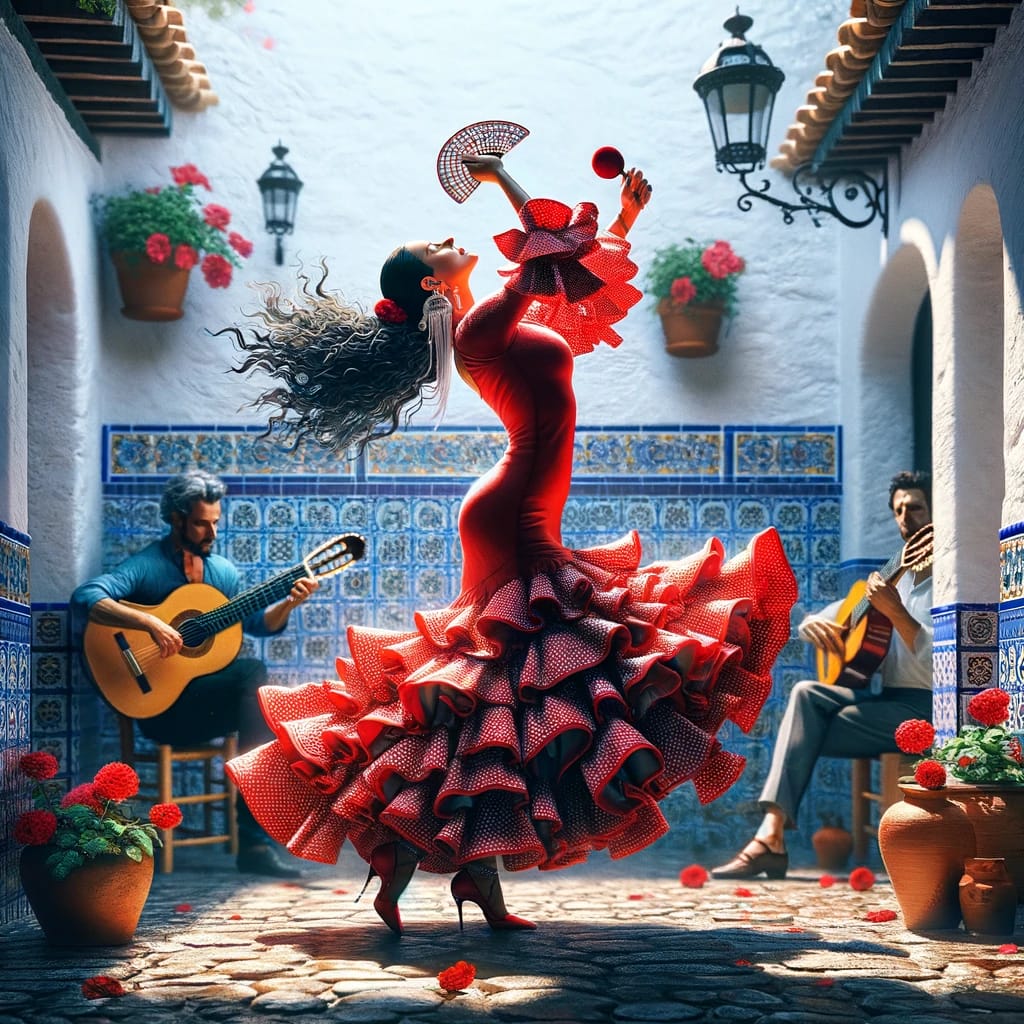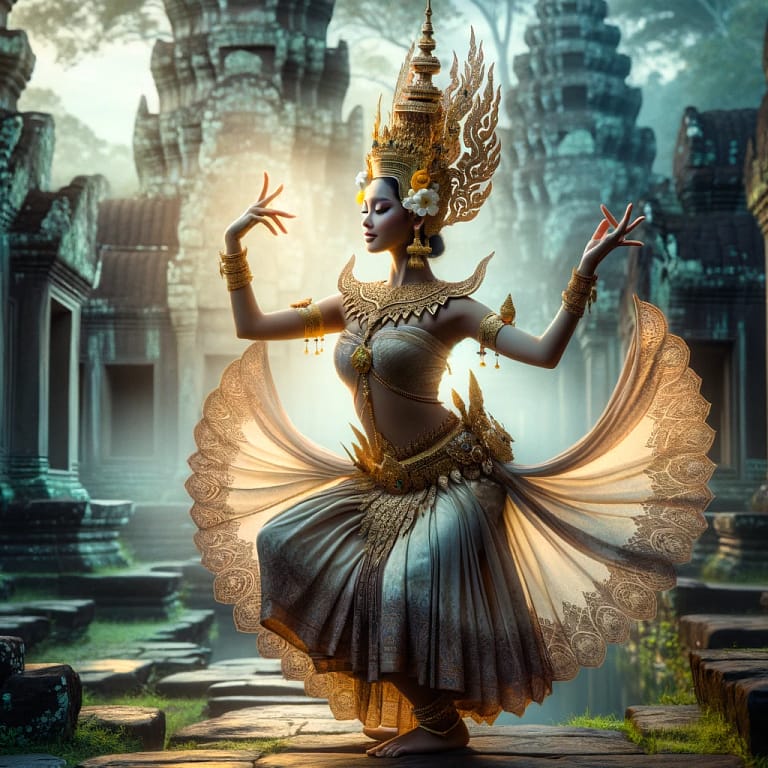Dance traditions around the world offer a glimpse into the cultural heart of societies, reflecting their history, beliefs, and social values. This overview introduces five diverse dance forms, ranging from traditional rituals to classical performances, highlighting the unique characteristics and cultural significance of each. These dances not only entertain but also preserve and communicate the essence of their respective cultures.
Flamenco (Spain)

Flamenco is a highly expressive Spanish dance form that originates from Andalusia. It combines guitar playing, singing, handclaps, and intricate footwork into a passionate performance. Flamenco is known for its emotional intensity, with dancers using their bodies to express a wide range of feelings. The dance has evolved over centuries, incorporating elements from various cultures, including Gypsy, Moorish, and Jewish traditions. Flamenco is often performed in intimate settings, where the connection between the dancers, musicians, and audience is central to the experience.
Bharatanatyam (India)
Bharatanatyam is a classical Indian dance form that is considered one of the oldest in the country. It originated in the temples of Tamil Nadu and is known for its grace, purity, and disciplined technique. The dance combines intricate footwork, expressive hand gestures (mudras), and facial expressions to tell stories, mostly derived from Hindu mythology. Bharatanatyam is not just a form of entertainment but a devotional offering as well. Dancers wear elaborate costumes and jewelry, adding to the visual appeal of their performance.
Kabuki (Japan)
Kabuki is a traditional Japanese form of theater that includes drama, music, and dance. It is known for its stylized performance, elaborate makeup, and the use of exaggerated facial expressions and gestures to convey emotions. Kabuki was founded in the early 17th century and has since evolved, yet it retains a strong emphasis on spectacle, including intricate costumes and sophisticated stage mechanisms. The repertoire of Kabuki includes historical dramas, domestic plays, and dance pieces. Despite being a male-dominated art form, with men performing all roles, Kabuki enjoys widespread popularity across diverse audiences.
Samba (Brazil)

Samba is a vibrant and rhythmic dance that embodies the spirit of Brazilian carnival. Originating from Afro-Brazilian communities, it has become a symbol of Brazilian national identity. The dance is characterized by rapid steps taken on quarter beats and a rocking, swaying motion of the dancers. Samba is usually performed to a fast-paced, drum-heavy music. It is a joyful dance that encourages participation and celebration among performers and spectators alike. Over the years, Samba has evolved into various styles, including Samba no pé, which is a solo dance, and Samba de Gafieira, a partner dance.
Hula (Hawaii, USA)
Hula is a traditional Polynesian dance from Hawaii that combines dance and chant (oli) or song (mele) to tell stories and convey emotions. It is a deeply cultural and spiritual performance that captures the history, mythology, and values of the Hawaiian people. There are two main types of Hula: the ancient Hula Kahiko, which is performed with traditional instruments and chants, and the more modern Hula ʻAuana, accompanied by guitar and ukulele. Dancers wear costumes made from natural materials and perform precise movements that represent elements of nature and human emotion.
Cossack Dance (Russia)

The Cossack Dance, or Kazachok, is a traditional Ukrainian and Russian dance characterized by its athleticism and showmanship. Dancers display remarkable feats of strength, agility, and acrobatics, including high kicks, splits, and squatting kicks. The dance is performed in brightly colored costumes that enhance the visual spectacle. Originally a martial dance, it has evolved into a celebratory performance that showcases the vitality and skill of the Cossacks. The Cossack Dance is often seen as a symbol of courage and freedom, reflecting the spirit of the Cossack communities.
Tango (Argentina)
Tango originated in the late 19th century in the working-class neighborhoods of Buenos Aires and Montevideo. It is a dance of intense emotion, characterized by close embrace, intricate footwork, and synchronized movements. Tango music is equally expressive, often featuring the bandoneón alongside strings and piano. The dance is known for its improvisational nature, where dancers communicate through subtle shifts in movement and posture. Tango has gained international popularity, evolving into various styles, including the traditional Argentine Tango, Uruguayan Tango, and Ballroom Tango. It is celebrated for its ability to convey complex emotions and the deep connection between partners.
Irish Stepdance (Ireland)
Irish Stepdance is a traditional dance form from Ireland, characterized by a stiff upper body and quick, precise movements of the feet. It gained international fame through performances like “Riverdance.” The dance can be performed solo or in groups, and it’s known for its rapid leg and foot movements, while the arms are usually kept at the sides. Competitions are a significant aspect of Irish Stepdance, with dancers often wearing elaborate, embroidered dresses or costumes and hard shoes that emphasize the rhythm of their footwork. The dance emphasizes rhythm, precision, and athleticism, rooted in Irish culture and history.
Morris Dance (England)

Morris Dance is a traditional English folk dance dating back to the 15th century, characterized by rhythmic stepping and the execution of choreographed figures by a group of dancers, often wearing bell pads on their shins, and wielding sticks, swords, or handkerchiefs. The dance varies by region, with some styles emphasizing high leaps and others more intricate arm movements and footwork. Morris dancing is usually performed to accompany folk music, played on traditional instruments like the fiddle, accordion, or pipe and tabor. It’s a celebratory dance, often associated with seasonal festivals and community events.
Kathak (Pakistan)
Kathak is a classical dance form that originated in the northern regions of the Indian subcontinent and is practiced in Pakistan. It’s known for its intricate footwork, spins (chakkars), and expressive gestures and facial expressions, telling stories through dance. Kathak dancers wear costumes that beautifully complement their movements and the dance’s storytelling aspect. It combines elements of both Hindu and Muslim traditions, reflecting the cultural synthesis of the region. Kathak is performed on classical music and involves complex rhythmic patterns, where the dancer’s feet may also be adorned with bells (ghungroos) that accentuate the footwork.
Belly Dance (Middle East)
Belly Dance, also known as Raqs Sharqi in Arabic, is a Middle Eastern dance form that emphasizes complex movements of the torso. It originated in Egypt and has spread throughout the Middle East and beyond. The dance is known for its fluid, graceful movements, and has both folkloric and performance aspects. Belly dancers often wear costumes that accentuate their movements, including hip belts decorated with beads and coins. The dance is typically performed to traditional Middle Eastern music, and improvisation plays a significant role in its execution. Belly Dance celebrates the human body’s natural movement and is often seen as a form of expression and empowerment.
Can Can (France)

The Can Can is a high-energy, physically demanding dance that originated in the working-class ballrooms of Paris in the 1840s. Known for its high kicks, splits, and skirt swirling, the Can Can was initially considered scandalous due to its revealing movements and the independent spirit of the women who performed it. Today, it is celebrated as a symbol of French joie de vivre and is performed by both men and women. The dance is often associated with the music of Jacques Offenbach, particularly his “Infernal Galop” from “Orpheus in the Underworld,” which has become synonymous with the Can Can.
Maori Haka (New Zealand)
The Haka is a traditional war dance of the Maori people of New Zealand, performed with intense facial expressions, body slapping, and vigorous movements. It serves various purposes, including welcoming guests, celebrating achievements, and preparing for battle. The dance is a display of a tribe’s pride, strength, and unity. The most famous Haka, “Ka Mate,” is performed by New Zealand’s national rugby team, the All Blacks, before their matches, showcasing the dance’s powerful cultural significance and its role in expressing collective emotions and identity.
Whirling Dervishes (Turkey)
The practice of the Whirling Dervishes is a form of Sama, a ceremony that represents a mystical journey of spiritual ascent through mind and love to the Perfect. Originating from the teachings of Rumi, a 13th-century Persian poet and Sufi mystic, the dance involves spinning in repetitive circles, symbolizing the journey towards spiritual growth and unity with the divine. The dancers, or dervishes, wear white robes symbolizing death, a wide skirt representing the shroud, and a tall hat indicating the ego’s tombstone. This dance is not just artistic expression but a form of prayer and meditation, deeply rooted in Sufi tradition.
Adumu (Maasai, Kenya/Tanzania)
The Adumu, often referred to as the Maasai jumping dance, is a traditional dance performed by the Maasai warriors of Kenya and Tanzania. The dance is a central part of the Eunoto ceremony, which marks the transition of warriors to senior warriors. Participants form a circle and take turns jumping as high as possible while maintaining a straight posture, without letting their heels touch the ground. The height of the jump is considered a demonstration of strength and stamina, and it attracts the attention of potential brides. The Adumu is an expression of Maasai culture, emphasizing community, competitive spirit, and passage into manhood.
Ballet (Russia)
Russian ballet is renowned worldwide for its precision, emotion, and dramatic storytelling. Rooted in a tradition that dates back to the 18th century, it gained prominence with the establishment of the Imperial Russian Ballet. Russian ballet is characterized by its rigorous technique, athleticism, and expressive artistry, with a repertoire that includes classical masterpieces like “Swan Lake,” “The Nutcracker,” and “Sleeping Beauty.” The training system, known as the Vaganova method, emphasizes whole-body technique and flexibility, producing dancers of exceptional calibre. Russian ballet continues to influence the global dance scene, showcasing the depth and richness of Russia’s cultural heritage.
Apsara Dance (Cambodia)

The Apsara Dance is a classical dance form from Cambodia, inspired by the celestial dancers of Hindu and Buddhist mythology depicted in the ancient temples of Angkor. This dance embodies the Khmer culture’s grace and spirituality, characterized by precise hand gestures and elaborate costumes that mirror the Angkorian era’s sculptures. The Apsara Dance tells stories of mythical realms and deities, emphasizing purity, serenity, and the beauty of divine dance. It was almost lost during the Khmer Rouge regime but has since been revived and is now a symbol of Cambodian national identity and pride.
Gumboot Dance (South Africa)
The Gumboot Dance originated among the black miners in South Africa under apartheid. Working in flooded gold mines, miners used gumboots for protection and developed a form of communication that evolved into dance. This dance involves slapping the boots and chains, creating rhythmic patterns that express both the hardship of the miners’ lives and their spirit of resistance and solidarity. The dance has since transcended its origins, becoming a powerful artistic expression of South African culture, storytelling, and social issues, performed worldwide by various dance troupes and at cultural events.
Tarantella (Italy)
The Tarantella is a lively folk dance originating from Southern Italy, associated with a traditional belief that dancing vigorously could cure the poisonous bite of the tarantula spider. Characterized by a fast tempo, the dance involves couples spinning, twirling, and moving lightly, often in a 6/8 rhythm. The Tarantella is a dance of courtship and is traditionally performed at weddings and community celebrations. Its movements and music vary by region but generally reflect themes of love, passion, and sometimes even healing. Today, the Tarantella remains a vibrant part of Italian cultural festivities, symbolizing joy and vitality.

